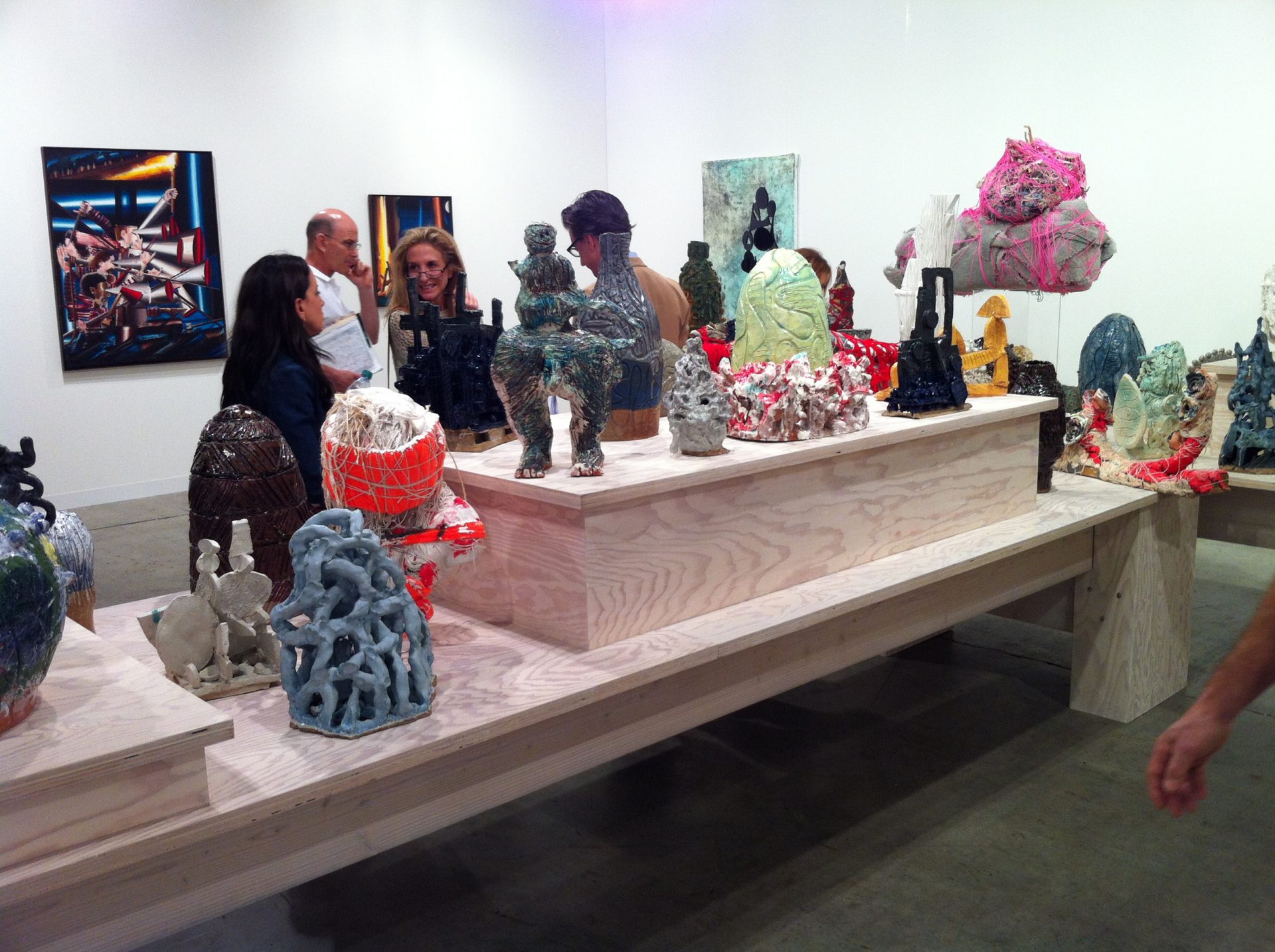
Artnet News
Oct. 19, 2010
SWEDISH BRILLOS ARE BUNK: WARHOL AUTHENTICATION BOARD
It’s one of the most famous arguments in all of art theory: Arthur Danto’s claim that Andy Warhol’s Brillo Box sculptures represent the “end of art,” because they don’t have any distinguishing features — it’s just art because the artist says it is. Well, the Andy Warhol Authentication Board begs to differ. In a 27-page encyclical (available for perusal courtesy the L.A. Times’ Christopher Knight), the board rules that a slew of more than 100 boxes are of dubious authenticity, essentially fabrications by free-wheeling Swedish curator and sometime Warhol collaborator Pontus Hulten (1924-2006). The board also lays out precise formal guidelines designed to separate the real Brillos from the clones.
In essence, the tortuous saga of the art fakes boils down to this: For a 1968 show at Sweden’s Moderna Museet, rather than include the actual Brillo Boxes from Warhol’s 1964 Stable Gallery show, Hulten had some 500 actual cardboard Brillo cartons shipped from the Brooklyn-based Brillo Factory to represent the sculptural side of the artist’s works. Later in 1968, Hulten had “ten to fifteen” new boxes fabricated in wood, based on the design of the cardboard containers, which he then gave away as “souvenirs” to collaborators, or kept for his own use. He even used two as “bedside tables for his children.” Much later, in 1990, Hulten had some 105 new boxes produced as “sceneography” for a show he was curating in Leningrad, based on his own 1968 replicas. These were then identified as 1964 originals when the show traveled.
This misattribution, combined with later assertions by Hulten that the works were produced in 1968 under Andy’s supervision, has led to an enduring confusion for Warhol collectors, even snookering the board itself, which certified the Swedish boxes as the real thing in 1994. It’s a confusion that the Warhol board is now endeavoring to put to rest with this heavily footnoted report, which even quotes Hulten’s own Marcel Duchamp-inspired musings to prove that he had little respect for concepts of originality.
So, where does that leave the question of the ontology of the fake Brillo Boxes? The Warhol Board doesn’t quite say. It stops short of calling the Swedish Brillos outright fakes. Instead, their new official designation is “exhibition copies.” And the matter does, it seem, all come back to the intention of the artist himself. The report notes that other Brillo Boxes were authorized remotely by Warhol for museum shows, though in those cases documents exist to verify his intention. No such documentation exists in the Swedish case — but Hulten always claimed that he was working with the consent of the artist, and the board concedes that “[g]iven the friendship between Warhol and Hulten, it is possible that a verbal agreement existed between the two” to create the disputed works, which would make them, essentially, originals.
Since the board’s has been embroiled in at least one long-running lawsuit over its authentication procedures, its hesitation to be definitive seems understandable.

Warhol Brillo boxes downgraded to “copies”
Authentication board says famous museum director “falsified” their history
By Clemens Bomsdorf and Melanie Gerlis | From THE ART NEWSPAPER, issue 217, October 2010
Published online 21 Oct 10 (News)
STOCKHOLM. More than 100 Brillo boxes, said to be works by Andy Warhol, have been declared “copies” by the Andy Warhol Art Authentication Board after a three-year investigation.
It centred on two series of boxes produced by the late Pontus Hultén (1924-2006), the founding director of the Moderna Museet in Stockholm, the Centre Pompidou in Paris and the Los Angeles Museum of Contemporary Art. Hultén claimed that Warhol authorised the production of the boxes for the seminal exhibition that Hultén curated in Stockholm in 1968. But in 2007, the Swedish newspaper Expressen discovered that no wooden boxes had been displayed in the show and that cardboard boxes from the Brillo factory had been used instead. It set out to research the date and manufacture of Hultén’s boxes, many of which had entered the market.
In 1994, the Belgian dealer Ronny van de Velde bought 40 boxes from Hultén for $240,000. Van de Velde told us in 2007 that he had certificates from Hultén confirming he was authorised by Warhol to extend the series. Between 2004 and 2006, Van de Velde secured stamps from the board confirming these were 1968 Brillo Soap Pads Box [Stockholm Type]. In 2004, the London dealer Brian Balfour of Archeus Fine Art bought 22 boxes from Hultén for around £640,000. Ten were sold through Christie’s shortly afterwards to a UK buyer for £475,650, who turned out to be the art dealer Anthony d’Offay. Balfour also had letters from Hultén and the Warhol authentication board.
In July, the board sent a report to Lars Nittve, director of the Moderna Museet, which holds six of the disputed boxes in its collection. It said it had “examined and re-examined” the “box sculptures”, Hultén’s personal papers and other museum archives, and were now downgrading the boxes to “copies”.
The board now says there are two sets of Hultén-produced boxes: a small number (about 10 to 15) made in 1968, straight after the show. The board refers to these as “Stockholm type boxes”. The rest, 105, were produced at Hultén’s request by carpenters for a 1990 exhibition in Russia. The board refers to these as “Malmö type boxes”.
According to the board, one differentiating factor between Warhol’s undisputed 1964 Stable Gallery boxes and Hultén’s, is a large “semi-circular blue field with the notation 1A400; 24/18; Pad Giant” on the upper corners (pictured). The board also states: “Neither the Stockholm type boxes nor the Malmö type boxes were made by Andy Warhol, to his specifications or under his supervision; and there is no known documentation that Warhol authorised their production.” The board now classes the Stockholm boxes as “exhibition-related copies” and the Malmö boxes as “exhibition copies”.
The board accepts that it can “neither verify or invalidate any verbal agreement” that may have existed between Warhol and Hultén, but it is damning on the latter’s version of events. Hultén’s boxes first came to the attention of the estate, it says, in December 1994. Hultén told them that the boxes were all made in 1968, “according to Andy Warhol’s instructions”, and that they had all been in the 1968 Moderna Museet exhibition. In doing so, the board says he “misrepresented these works and falsified their history”.
Brian Balfour told us he has been left in an uncertain position. “The board hasn’t revoked these certificates, but they’ve given a certain impression,” he said. “In any event, the [board] protect from the front end,” he added, explaining he had to sign a no-fault disclaimer before he received his authentication.
The board avoids using words such as “fake” or “inauthentic” in its report, and failed to respond to our requests for clarification. Nor would it say whether or not it will stamp any boxes presented to it as “denied”, or revoke existing letters of opinion.

